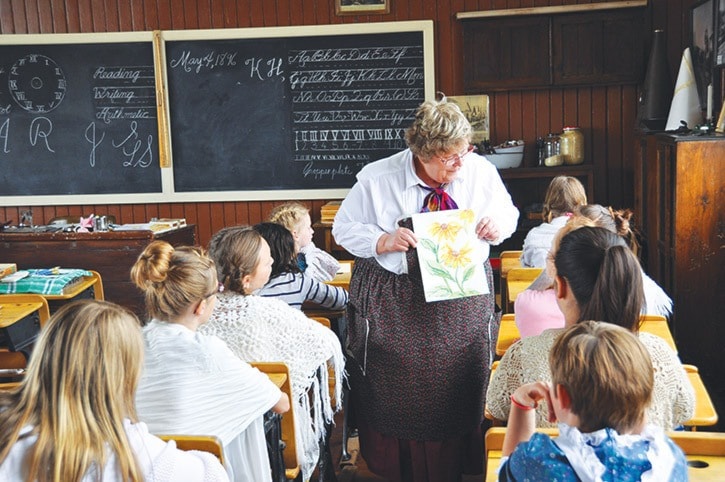Local students enjoyed a unique opportunity to step back in time and experience school life in 1896, thanks to efforts of retired teachers Audrey Dye and Chris Donaldson.
When elementary school students lined up outside the little red school house in 150 Mile House, summoned by the old-fashioned bell beside the door, they took on the character of a local pioneer.
They donned costumes and assumed the mannerisms of students of the era, including standing quietly in the aisles beside their seats, calling their teacher Ma’am, bowing and curtsying and answering questions in complete sentences.
“This building opened in 1896,” explains Audrey Dye. “Before that, there was a little school on the hill, donated by a rancher. It was a small, unused stable with a sod roof. The chimney smoked, there were no windows and it was dark, dank and smoky. Parents didn’t want their children in that building so they got together and built this one.
“This is the first school in the Williams Lake School District. It was called that even though there wasn’t really a Williams Lake town yet.”
She said students bring lunches as close to the era as possible; some bring lunch tied in a handkerchief on a stick, or in a lard pail or basket. “They’re asked to bring nothing in plastic and they bring their drinks, milk or water in Mason jars,” she continued.
“They practice copperplate writing with pens, nibs and ink; the younger ones use the slates and pencils.
“We talk about life beyond the school room, too, including what a treat it was for rural children to visit the general store run by Mr. Borland and Mr. Veitch. We would have watched all the wagons heading north to Barkerville. All the kids in those days would have come from ranching or families and they wouldn’t get to go the store often,” she added.
“We give them a taste of what a treat those visits were; if children were lucky they would have been given a penny to spend on candy and would have received a waxed paper envelope full of candy.”
The children also learn about how food was preserved in the days of no refrigeration.
“They learn about having nothing disposable, that a simple piece of waxed paper was used again and again until it shredded apart and was used for fire starter. Water was conserved because you had to pack it from a well or a river,” Dye said.
Currently classes from 150 Mile School take part in the two-week program. Other schools have taken part in the past and Dye said she’d like to see it expand.
“The kids, they love it. They all want to come and don’t want to miss out. It’s important for them to get a sense of the reality of that era: the lack of electricity and technology. They love to play act and really get into it,” she said.
“It’s so much fun. Some kids are related to some of the local pioneer names and love to re-enact their ancestors. When they come year after year, what they remember from here is astounding.”
